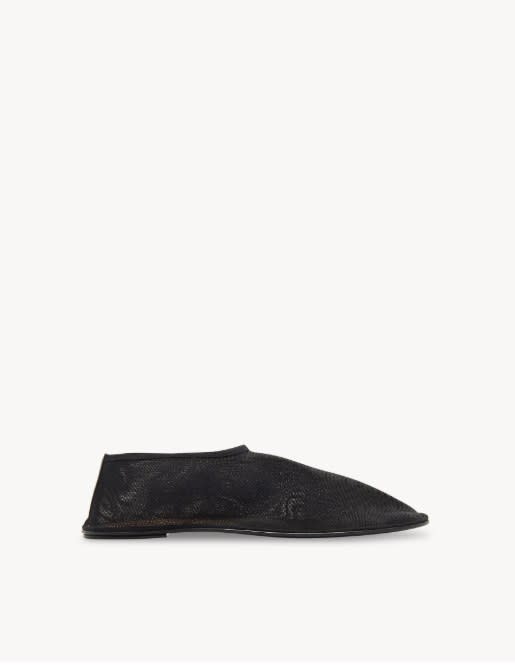The Most Advanced Shoes In Fashion Are Barely Even Shoes
Usually, the release of a new Yeezy sneaker is greeted by tongues wagging and fingers racing to add the new style to the cart. But last week, a new release prompted the internet’s deranged chagrin: the “Foam Runner,” a shoe with same snub nosed silhouette as the Yeezy Boost 700, but crafted from a white, ventilated foam-resin mocassin. Appearing as a part of an editorial in the revitalized The Face magazine, its strange design inspired seemingly every person logged onto Twitter to compare it to everything from a Croc to a colander, and also the sanitary booties worn by hospital workers. The shoe first debuted earlier this summer on West’s daughter North, when it also drew comparisons to the foam comfort clog beloved by chefs and gardeners.
This wasn’t the first time that a Yeezy release was met with a tidal wave of meme mockery. In May, a pair of sneaker-socks West wore on an Erewhon errand was also “slammed” on social media. It seemed a system of Yeezy prototype hysteria had codified: Kanye test-drives a new shoe, and the Internet screams.
At Yeezy, the prototype is something of its own product category, a mythical object that arrives with no fanfare, inspires confusion and lust, and promptly disappears—sometimes forever. West in fact launched his sneaker design career with a prototype, debuting the Air Yeezy, a black leather Nike hi-top he designed with Tinker Hatfield, during a Grammys performance in 2008. (The sneaker came to market the following year.) The Foam Runner wasn’t even the first Croc-esque prototype that West circulated: in spring 2018, in the midst of a return to Twitter that was possibly a live-tweeted philosophy manuscript, West shared photos of a chalk-blue slide with a jagged treaded sole. That prototype never made it to market. And in July, West posed in Forbes surrounded by a pastel spiral of his prototypes, like a sneakerhead take on land art or a cult figure surrounded by his followers rising to salute their leader—as if the shoes that might have been were somehow more exalted than the “real” shoes themselves.
What sets the Foam Runner apart from many of those prototypes, though, is that it’s actually made it out into the world—but it doesn’t really look like it should have. If the shoes in that Forbes spread look like feasible sneakers, the Foam Runner looks like an experiment, a proposal for the very future of putting things on your feet. (West is also in the midst of designing a new residential concept, the prototypes for which he also toured with Forbes.) Part of the reason the Foam Runner was so virally mocked is its improbably futuristic appearance, which seems designed to solve problems we’ve yet to recognize. The scientific silhouette and material, plus the fact that it’s not even a sneaker, make it look like a trial run—a secret we’re not yet meant to know about, a controversial antidote in a test tube guarded by astronauts.
Yeezy is not the only brand making shoes that feel like the space between a sketch and a fully formed product. For Spring 2020, Dries Van Noten showed men’s leather flats that, with their soft skin and almost naive finish, appeared to be the rehearsal shoe for an experimental ballet. Jil Sander made a similar model, a glove or sock-like second skin that fits tautly on the foot, like a ballet flat with no style cred. The Row is making similarly incomplete shoes: the fall collection arriving in stores now includes the “Sock Shoe,” with a nylon upper in various neutrals and a wisp of a leather sole (a number of men I follow on Instagram are buying this shoe, which feels like an oddly comfy pair of pantyhose). In the spring collection the brand showed last week, they introduced another variation, which looks like plastic, like tape or saran wrap. The Sock Shoe, like the Yeezy sneaker-sock prototype, looks like the lining ripped out of another, fancier shoe—like something that isn’t meant to be worn out on the street.

And actually, all of these shoes look like they aren’t really meant to be seen. They have a strange aura of the human hand around them, which footwear rarely does. You can see the effect on the Instagram of “sneaker collagist” Helen Kirkum, who has worked with brands including Timberland, and creates her own DIY collaborations, in which she Frankensteins sneaker parts together with a finish that shows the hand—sloppy stitches, loose hems, distressed materials, and not-quite-symmetrical uppers, as if the collision of pieces is a once-in-a-lifetime experience. (Virgil Abloh’s original “The Ten” collection for Nike in 2017, with its unexpected mashups and exposed construction, marked a mass-audience move towards the prototype direction.)
The prototype looks like a secret step in pursuit of a more comfortable shoe, or a more pared back shoe; it seems like practical design in its purest form. But the effect is something more otherworldly. Totokaelo is currently stocking a slip-on version of their cult Tabi boot, which, with its worn leather and basting stitches (which are usually temporary placeholders for permanent stitches or glue), looks like a strange folly that a few of the younger accessories designers decided to try out with leftover materials during the downtime between collections. They come in three colorways, and are a slightly more affordable, comfier alternative to the full-blown boot. But their design and construction make them look rare. If the most recent wave of hype shoes—chunky sneakers like the Balenciaga Triple S—announced their presence and begged to be Instagrammed, the prototype suggests that if you blink, you’ll miss it—either because it fell apart, or because it was barely there in the first place.
Originally Appeared on GQ
